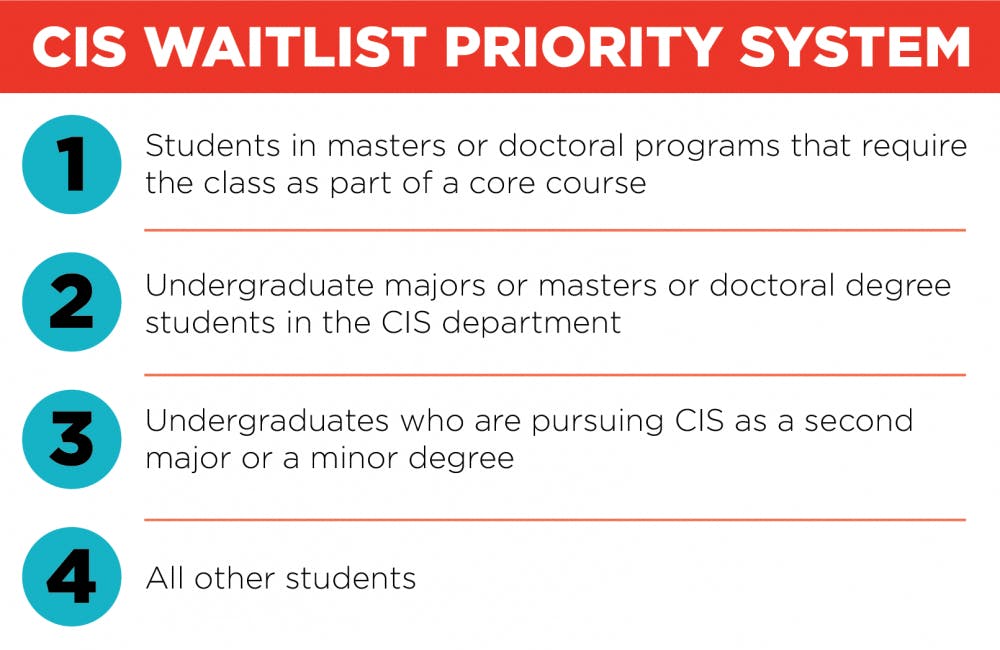
A packed Computer Science classroom.
Credit: Joy LeeIn the spring of 2018, there were 377 waitlist entries submitted for a Computer and Information Science elective course entitled, "Applied Machine Learning," which caps enrollment at 150.
While machine learning is a popular subject now, high demand for CIS courses across the board has become problematic in recent years. CIS Undergraduate Curriculum Chair Andreas Haeberlen said he is "painfully aware of the high demand” for CIS classes this upcoming semester, adding that enrollment will only rise in many of these courses.
This high demand — which stems from CIS majors, CIS minors, and students taking CIS courses as electives — leaves some students struggling to satisfy major and minor requirements because they are stuck on waitlists for mandatory courses.
Next semester, the CIS Department is offering 35 courses, many of which have seen record numbers in enrollment, and administrators say demand is beyond what the department's resources can supply.
Wharton and Engineering sophomore Younghu Park decided to pursue a dual degree after she took CIS 120 and was hooked on computer science. She said she would not have been able to pursue a dual degree if she hadn't gotten off the waitlist for CIS 120.
“In order for me to stay on track for a double degree I [needed] to take all those CIS classes,” Park said. “For 120 I thankfully got off the waitlist. I don’t think I would’ve tried to do CIS if I didn’t get into that class because I really liked 120, and I only decided to continue [with the dual degree] after taking that class.”
Haeberlen said classes can only get so large before they become unmanageable, and there are only so many resources and faculty within the CIS Department.
“There are limits to how large we can make a given class and still do a good job,” Haeberlen said. “For my class this spring I personally wrote 1,260 Piazza messages; if I made the class twice as large, that just wouldn't be sustainable anymore.”
“Right now the machine learning classes are hugely popular, but we only have so many professors who are working in this area and can teach these classes,” he added. “The department is trying to hire aggressively, but this takes time and will only help in the longer term.”
Wharton and College sophomore Hoyt Gong is in the Roy and Diana Vagelos Program in Life Sciences & Management, but is also trying to pursue a minor in CIS. This semester, he was placed on the waitlist for a CIS course on big data analytics – one that was a requirement for his minor.
“Although I ranked the course as one of my top choices it’s unfortunate knowing that, as an undergraduate student, the chances of me getting in are close to zero,” Gong, also a Daily Pennsylvanian staffer, said. “While I understand the system in place is valid and that masters and graduate students should get priority, I think the lack of space in any CIS course given the high demand speaks to potential changes in class sizes and hiring more faculty in CIS.”
The CIS waitlist system prioritizes student enrollment requests for popular classes based on four categories. Those with first priority are students in masters or doctoral programs that require the class as part of a core course. Second priority students are undergraduate majors or masters or doctoral degree students in the CIS department. Third priority students are undergraduates who are pursuing CIS as a second major or a minor degree. The fourth include all other students.

“At the end of the day, if I’m at such low priority am I ever going to finish a CIS minor and take CIS courses I’m interested in but can’t get into?” Gong said.
Haeberlen acknowledged it would be more difficult to get into a desired course as a College student pursuing a second major in CIS than as an Engineering student majoring in CIS.
“The idea here is that, if two students need the same CIS class, both didn’t get in during advance registration, and one needs it for a second major while the other can’t even finish their primary CSCI major without it, we would give priority to the latter when a spot becomes available,” he wrote in an emailed statement.
One of the Engineering School’s biggest campaign priorities under the Power of Penn is faculty. While it is unknown how much of the funding will go toward hiring CIS faculty, the Power of Penn’s Engineering branch currently has its sights set on raising $65 million to “recruit and retain renowned faculty.”
The Daily Pennsylvanian is an independent, student-run newspaper. Please consider making a donation to support the coverage that shapes the University. Your generosity ensures a future of strong journalism at Penn.
Donate





